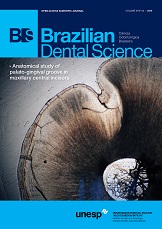Oral health in relation to nutritional status, age and sex among 14-18 years children of Naraingarh, Haryana
DOI:
https://doi.org/10.14295/bds.2015.v18i3.1127Resumo
Objective: To describe prevalence dental caries and to study the association between nutritional status and oral health based on various indices among adolescents from under privileged communities. Material and Methods: The study was based on a cross-sectional sample of 196 apparently healthy children (104 males and 92 females) in the age range of 14 to 18 years belonging to under-privileged communities. Each subject was measured for height, body weight to assess nutritional status and clinically observed for various oral health traits like dental caries, plaque, calculus and gingivitis. Results: Decayed, missing due to caries and filled teeth (DMF) index was low among adolescent children; it was 0.48 in males and 0.93 in females. Prevalence of calculus was higher among females through all age groups, while prevalence of plaque was higher among males. Sex differences were significant only for plaque index and DMF index. The inadequacy of nutrition was not a major determinant for the observed magnitude of soft deposits, plaque and calculus indices except for Oral health status index and DMF index where higher magnitude of the indices were observed in underweight children than the normal. Conclusion: The inadequate nutritional status was not a major determinant of oral health indicating the general awareness of oral hygiene and its observance was a major factor. Females were more prone to dental caries than the males and the severity was also significantly higher in the former.
Keywords
Oral health; Nutritional status; BMI-for-age Z-scores; Periodontal health indices; Adolescence
Downloads
Downloads
Arquivos adicionais
Publicado
Como Citar
Edição
Seção
Licença
TRANSFERÊNCIA DE DIREITOS AUTORAIS E DECLARAÇÃO DE RESPONSABILIDADE
Toda a propriedade de direitos autorais do artigo "____________________________________________________________________" é transferido do autor(es) para a CIÊNCIA ODONTOLÓGICA BRASILEIRA, no caso do trabalho ser publicado. O artigo não foi publicado em outro lugar e não foi submetido simultaneamente para publicação em outra revista.
Vimos por meio deste, atestar que trabalho é original e não apresenta dados manipulados, fraude ou plágio. Fizemos contribuição científica significativa para o estudo e estamos cientes dos dados apresentados e de acordo com a versão final do artigo. Assumimos total responsabilidade pelos aspectos éticos do estudo.
Este texto deve ser impresso e assinado por todos os autores. A versão digitalizada deverá ser apresentada como arquivo suplementar durante o processo de submissão.




























